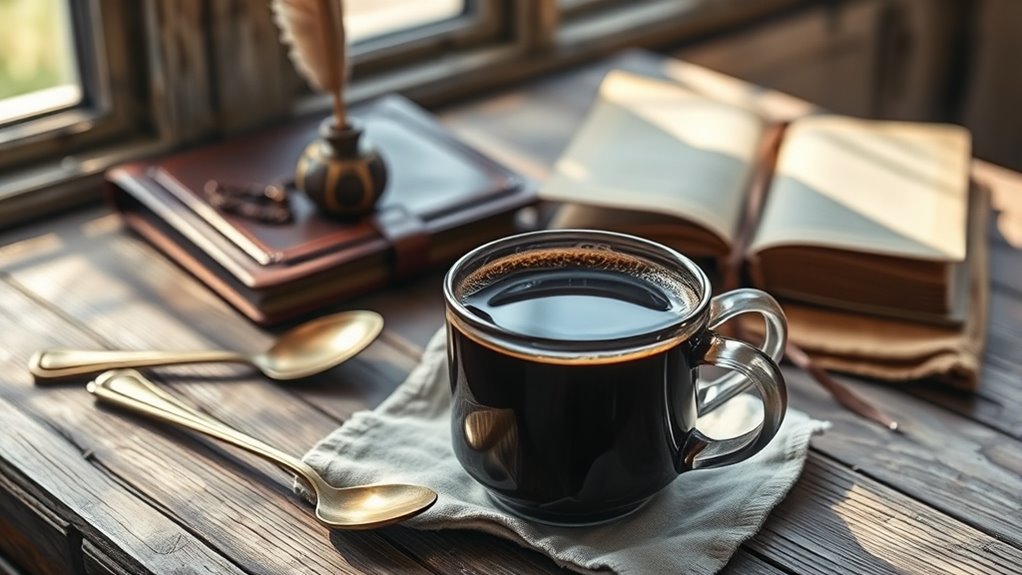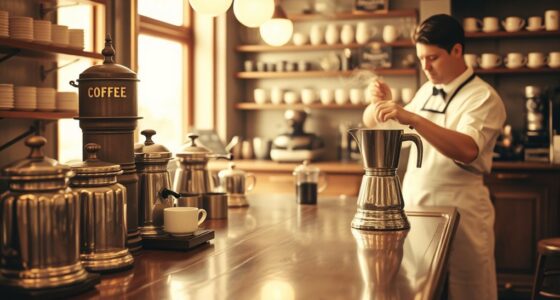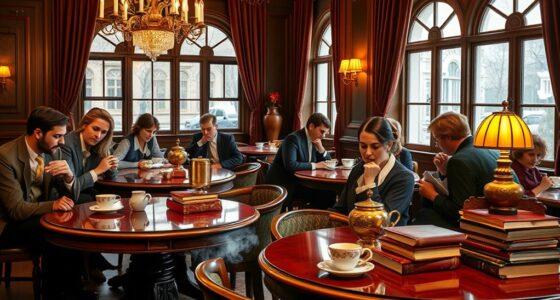In the American colonies, coffee became more than just a popular beverage; it transformed social life and politics. Introduced by Dutch traders around 1640, coffee quickly gained status and was brewed in coffeehouses that served as hubs for news, debate, and community bonding. During the American Revolution, drinking coffee symbolized patriotism, replacing taxed tea as a statement of independence. If you want to discover how coffee shaped colonial society further, there’s more to explore.
Key Takeaways
- Coffee was introduced by Dutch traders around 1640 and became a social and political hub in colonial America.
- Coffeehouses served as gathering spots for news, debate, and social cohesion across different classes.
- Coffee trade was regulated and linked to colonial economic development, with entrepreneurs like Dorothy Jones gaining licenses.
- Drinking coffee symbolized social status, modernity, and cultural identity in colonial society.
- Replacing tea with coffee during the American Revolution became a patriotic act and symbol of independence.

Coffee in the American Colonies played a essential role in shaping social and political life, especially as it gained popularity in the late 17th century. When you start drinking coffee in colonial America, you’re joining a growing trend that influences both everyday routines and the larger political landscape.
Coffee’s arrival, brought by Dutch traders around 1640, marked the beginning of a new social ritual. As the coffee trade expanded, colonial merchants began cultivating coffee beans, with George Washington himself planting seeds at Mount Vernon, emphasizing how deeply coffee became intertwined with colonial identity.
Coffee arrived via Dutch traders around 1640, becoming a key part of colonial identity and social life.
In colonial America, coffeehouses quickly emerged as central hubs of social and political activity. These establishments, like Boston’s London Coffee House opened in 1689, served as lively gathering spots where colonists discussed news, politics, and business.
By drinking coffee, you’re participating in a space that fosters debate and social cohesion across different classes. Coffeehouses became the backbone of colonial society, providing a neutral ground for diverse groups to exchange ideas and strengthen community bonds.
The regulation of coffee trade was strict initially; colonists needed licenses to trade or sell coffee. Dorothy Jones, who became Boston’s first licensed coffee trader in 1670, symbolizes the early entrepreneurial spirit surrounding coffee in colonial America. Her success highlights how coffee trading wasn’t just a matter of taste but also a significant part of the colonial economy.
As coffee gained popularity, it became more than just a beverage—it became a symbol of status and modernity in colonial society.
During the American Revolution, coffee’s significance deepened. When colonists boycotted taxed tea to protest British taxation, drinking coffee became a patriotic act.
Replacing tea with coffee, colonists made a statement of independence and resistance. Coffee was no longer just a drink but a symbol of patriotism, embodying the spirit of defiance against British rule.
This shift helped solidify coffee’s place in colonial American culture, illustrating how a simple beverage could influence political sentiment and unify people in their fight for independence.
Furthermore, the colonial economy adapted to include coffee trade, demonstrating its growing importance in economic development.
Frequently Asked Questions
Was There Coffee in Colonial America?
You’re wondering if coffee was in colonial America. Yes, it was introduced by Dutch traders in the early 1600s. You’d find it in places like New Amsterdam, and colonial Americans started importing beans from the Caribbean.
Coffeehouses became social and political hubs, and even George Washington experimented with cultivation. By the early 1700s, coffee was a popular beverage among the colonists, especially the merchant and political classes.
When Did Colonists Start Drinking Coffee?
You’re curious about when colonists started drinking coffee. They began enjoying it in the early 17th century, around 1640, thanks to Dutch traders importing beans.
By the 1720s, coffee became more popular as trade expanded and coffeehouses opened.
By the mid-1700s, it was a common beverage for many social classes.
During the Revolutionary War, coffee replaced tea as the preferred morning drink, cementing its place in society.
How Did People Drink Coffee in the 1700S?
You drink coffee in the 1700s by brewing grounds in simple pots or makeshift filters, often boiling them in water.
You typically serve it black or with sugar and milk, in small cups or mugs.
Whether at social gatherings in coffeehouses or at home, you enjoy it communally, using whatever tools you have—like improvised filters—making it a symbol of independence and social activity during that era.
Where Did Settlers Get Coffee?
You might wonder where settlers got coffee during that time. They primarily imported beans from the Caribbean, especially Jamaica and Dutch colonies, with Dutch traders playing a key role. Many also smuggled coffee to avoid taxes, making illegal trade common.
Some settlers obtained coffee seeds from Europeans, like George Washington did from Thomas Law in 1799. Black market channels and illegal imports kept coffee widely available despite restrictions.
Conclusion
So, as you can see, coffee quickly became a beloved part of colonial life. It connected people through lively gatherings and fueled their daily routines. You might find it surprising how this simple beverage played a role in shaping social and cultural habits during those times. Next time you enjoy your coffee, remember its roots in the American colonies and how it helped forge a sense of community that still endures today.









